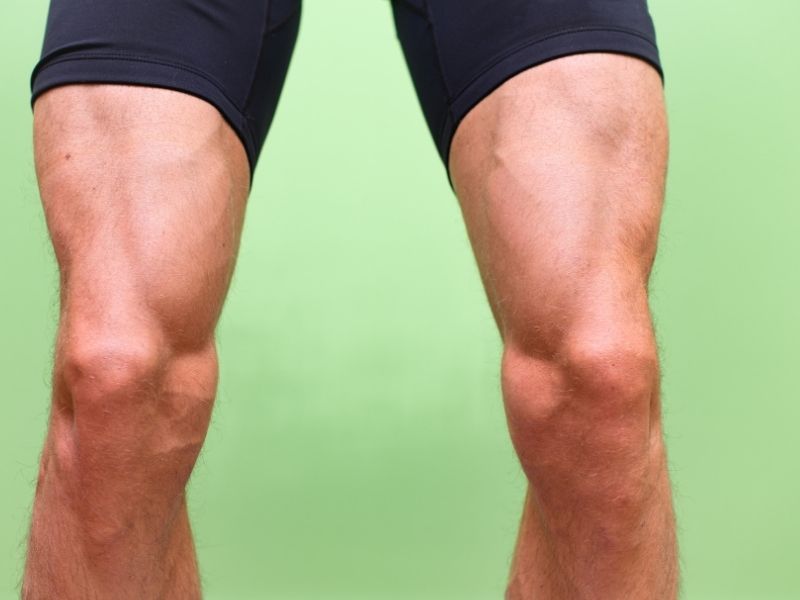Top 6 Quadricep Release Techniques – DIY Or With Help

Table of Contents
The quadricep muscle group contains 4 muscles: vastus lateralis, vastus medialis, rectus femoris, and vastus intermedius.
Excess tension in these muscles can contribute to stress in the knees, hips, and lower back.
How to know if you may need the following quadricep release techniques:
- Anterior pelvic tilt
- Knee pain
- Patellar tracking issues
- Lower back pain
- Thigh pain
- Hip pain
- IT band syndrome
Are Your Quads REALLY Tight?
So how do you know if your quadriceps are actually tight?
The easiest way to tell is to assess the quads in the same position as we test the hip flexors in, which is called the Thomas Test.
We need to differentiate tightness between the tightness of the rectus femoris (part of the quadriceps that flexes the hip) and the rest of the quadricep muscles.
Quadriceps Release – Massage Therapy
The quadriceps are often quite sensitive to soft-tissue techniques, so massage therapy isn’t my first choice to address tight quads, but pin and stretch techniques (such as Active Release Technique) can help.
The emphasis doesn’t necessarily need to be a high amount of pressure, but rather a moderate sustained pressure for a longer period of time (for example 2 minutes). I always recommend following up with stretching as a home assignment to lock-in the results.
In this video, John Gibbons demonstrates this technique:
Quad Stretch – Standing
Quad Stretch – Kneeling Hip Flexor Position
The kneeling hip flexor stretch is by far the most versatile quadriceps release stretching technique.
It allows you to maintain your balance and emphasize the pelvic tilt aspect of the stretch. The primary emphasis of this stretch is going to be the rectus femoris.
As the stretch gets easier, the back foot can be elevated slightly to add more tension to the quadriceps.
Quadriceps Release – Percussion Therapy Tool
Percussion tools can be useful for releasing tight quadriceps. Generally, most people just use the tool to massage the quads without regard to position, but I prefer to place the muscle under stretch as the percussion is applied.
Watch the video below for details:
VIDEO
Quadriceps Release – Graston-IASTM Therapy Tool
Graston-type IASTM (instrument assisted soft tissue mobilization) tools can be helpful for reducing quadriceps muscle tone and improving range of motion.
Some techniques can be self-applied, but this is a good reason to see a professional therapist.
Quadriceps Release Technique – Foam Roller Self-Massage
Self-massage for the quadriceps is easily do-able with a standard foam roller. The goal is to roll with a light-moderate level of discomfort that allows you to comfortably work on the tissues.
When you find areas that are particularly tender (quad trigger points), hold those points for 10-15 seconds, then move to another area.
Continue this process until you treat the areas that you can access effectively.
VIDEO
Thanks for checking out these quadricep release techniques. Keep in mind that any techniques presented here need to be applied in the context of an overall corrective strategy aimed at addressing the root cause of the issue, whether that is chronic pain, tension, or reduced performance.
To learn more, see my services page, or my online system, the Posture Hacking System.
Sam Visnic
I’ve spent my life studying the fundamental aspects of human health with a focus on movement and clinical massage therapy. In a world of specialists, surgical procedures, drugs and quick fix remedies, I’m committed to finding and developing strategies that help people stuck at the “gap”. Over the last 20 years I’ve studied dozens of systems and methodologies for uncovering the root cause of aches and pains, along with postural and movement issues. Pain science, the art and science of hands-on soft tissue massage techniques, myofascial release, and coaching movement is essential in my practice. Integrating different methods but above all deciphering WHEN to use different techniques with different people and situations, along with integration of movements that people want to be able to do again is the key to long term success with my incredible track record with clients. Understanding the various elements that contribute to conditions and the power of communication and education makes my Release Muscle Therapy program separate from other hands-on therapy approaches.
Blogs You May Be Interested In
Categories
-
Deep Gluteal Pain Syndrome
-
Deltoids
-
Fallbrook
-
Foam Rolling
-
Glutes
-
Hamstrings
-
Hypnosis For Pain
-
Lats
-
Levator Scapulae
-
Lifestyle
-
Massage Therapy
-
Mobility
-
Movement and Exercise
-
Murrieta
-
Muscles
-
Nutrition
-
Obliques
-
Pain
-
Pectorals
-
Piriformis
-
Plantar Fasciitis
-
Product Review
-
Psoas
-
Quadratus Lumborum
-
Quadriceps
-
Rhomboids
-
Serratus Anterior
-
SI Joint
-
Sternocleidomastoid
-
Stretching
-
Subscapularis
-
Temecula
-
TMJ
-
Trapezius
-
Uncategorized


















